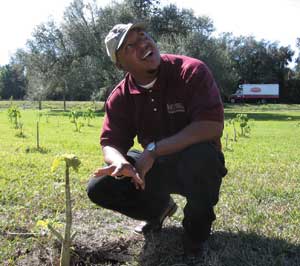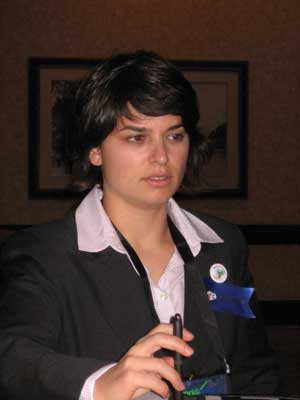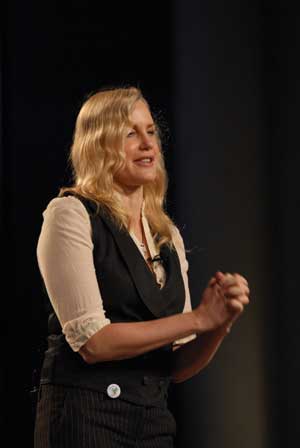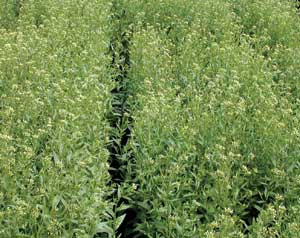Feedstock Development and Sustainability






March 17, 2008
BY Susanne Retka Schill
Two issues took center stage at the fifth annual National Biodiesel Conference & Expo in Orlando, Fla.-developing new feedstocks and sustainability. During the opening day's general session, National Biodiesel Board leaders announced initiatives in both areas. NBB Chairman Ed Hegland introduced the newly appointed chairwoman of a nine-member sustainability task force, Emily Bockian Landsburg, manager of business development at Philadephia Fry-O-Diesel. "We want to develop a comprehensive, holistic, long-term policy," she said. "We need to address sustainability proactively. There are a lot of myths about the negative impacts of biodiesel. We need to identify any negative impacts and how we can do it better." The remaining members of the task force have not yet been appointed. In describing the challenge ahead she said, "It's extremely complex, with a lot of diverse interests and a need to approach it wisely."
NBB Secretary Graham Noyes of Imperium Renewables Inc. voiced his support for the task force in the opening session panel discussion, pointing to the worldwide debate that erupted over palm oil biodiesel in the past year and the leadership of the Roundtable on Sustainability toward establishing criteria. "I think the sustainability issues are going to carryover into soy and canola," he said. "I think there's an opportunity to get some standards in the international community so there's not a patchwork out there." It can be difficult to combat negative public opinion even when it's baseless, Noyes said. "We at Imperium have taken a lot of criticism for producing palm biodiesel, but we haven't produced any," he said. "To talk about it was enough for folks to start criticizing us. The fact that we decided for sustainability issues, among others, not to go forward with [palm biodiesel] wasn't enough to stop the one-liners."
The expansion of palm oil production and other feedstock developments have raised concerns about deforestation and land use changes, Bockian Landsburg said. "We need to address those directly, because if we don't, others will, and we'll be reacting," she said. "We need to take a hard look at ourselves as an industry. Are we doing things that are intensifying negative consequences?" She suggested the industry should stress biodiesel's positive attributes such as energy independence, economic development in small communities, energy security, greenhouse gas reductions, its small carbon footprint and energy balance. "If we're shipping feedstocks in, what does that do to our energy independence and our energy balance?" Bockian Landsburg asked. "We need to realize that if we increase those social and environmental benefits, we increase the value of our fuel. True environmental and social sustainability is inextricably linked to economic viability." After the hearty applause following her comments subsided, panel member Gary Haer, NBB vice chairman from Renewable Energy Group Inc. responded, "You're exactly right, we as an industry have to take the initiative in this effort, and I know the membership is fully supportive."
In her brief comments at the opening session, actress Daryl Hannah talked about the perseverance of the organizers of the independent Sustainable Bioidiesel Summit, which has been held prior to the NBB conference the past several years. She applauded the new task force and the inclusion of a breakout session on sustainability in the conference while making an impassioned appeal to the biodiesel industry to take global warming seriously. "We need to educate ourselves in sustainable feedstocks, production and distribution models," she said. "We need to take the lead and rebuild the faith and the promise of biodiesel. If you're not involved in sustainable solutions, you are part of the problem."
Sustainable Biodiesel
The breakout session on sustainability was one of the best attended the first day of the conference, attesting to growing interest in the issue. Kent Bullard, who created and manages a Web site called SustainableOptions.com and is a member of the Sustainable Biodiesel Alliance, moderated the panel which included K. Shaine Tyson of Rocky Mountain Biodiesel Consulting, Jake Stewart of Organic Fuels Inc. and Lyle Estill of Piedmont Biofuels Inc.
Tyson, who worked for the National Renewable Energy Laboratory prior to starting her own consulting firm in Colorado, outlined criteria considered in sustainability analysis as well as factors considered by feedstock users. While many look to jatropha as a sustainable feedstock, Tyson wondered whether all factors have been considered such as the oilseed's toxicity, which would make the meal undesirable. "We need to learn more about these risks," she said. Some suggest the meal could be used as a fertilizer. Have the economics of transporting it back to the field and spreading it been considered? Tyson asked. And, though not a food crop, there still is a potential for jatropha to displace small land holders and food crops, she said.
In contrast to jatropha, Tyson introduced another new alternative biodiesel feedstock, Moringa oleifera. A native to India where 80,000 acres are currently grown, the small tree crop has multiple food uses. Moringa's leaves can be sold for salad. Its meal, seed and leaves are high in essential amino acids and its immature pods, which resemble asparagus, are edible. As a biodiesel feedstock, Moringa yields 3 tons of seed per hectare (1.2 tons per acre), producing 30 percent to 40 percent oil that contains 65 percent oleic acid. Getting food and fuel from a single crop is most desirable, Tyson said. "Moringa looks like the more sustainable crop," she added.
Stewart addressed greenhouse gas reductions and energy balance using numbers published by the Europeans. Those numbers suggest that biodiesel has a good carbon footprint, with a 78 percent carbon dioxide reduction compared with fossil fuels, and a positive energy balance at 3.2:1 for soy biodiesel, Stewart said. The sustainability criteria recently released in the European Union calls for a minimum greenhouse gas reduction of 35 percent, he said. Impacts from land use change are to be included in greenhouse gas calculations, and no material from virgin forests or material associated with high nitrous oxide levels are to be allowed, Stewar said. The EU's sustainability criteria also call for incentives to use idle lands and deserts for feedstock production.
From the perspective of a small biodiesel producer, Estill said, "I always thought of sustainability as free and easy." He championed the benefits of sustainability in the appropriate-scale, grassroots biodiesel world. "The future of energy lies in distributed production," he said. While many in the biodiesel industry are shutting down production, Estill added "at Piedmont our phone still rings with people who want to build small plants." He also reported receiving calls from others who were tearing out biodiesel plants and asking if Piedmont is interested in the tanks.
Feedstock Development Program
Several conference sessions addressed feedstock development. The Wednesday session called "Exploring the Possibilities" introduced several promising feedstocks. Roy Beckford of the University of Florida talked about his work in studying jatropha production in southwest Florida. Rafael Hernandez of Mississippi State University briefly covered his work using oil-bearing microbes grown in wastewater treatment facilities as a biodiesel feedstock. Jack Gallagher of the University of Delaware described his studies of seashore mallow as a potential new feedstock. Seashore mallow is a crop of interest because of its high tolerance for saline conditions. Dick Auld from Texas Tech University reviewed the university's work on winter canola, fall-planted safflower and castor oil.
Alan Weber vice president of MARC-IV Consulting Inc., is leading the NBB's feedstock development program, where he is in the process of compiling a summary of alternative feedstocks and assembling an industry-manned advisory board for the effort. "We're looking for areas where a trade association might have a role to speed along the development of these feedstocks," Weber said. Using camelina as an example, at least two private firms in Montana and the Pacific Northwest are currently working to establish the new crop as a biodiesel feedstock, he said. In the future, NBB as a trade association could assist with feedstock development efforts by addressing the broader issues that need to be resolved, such as working with federal agencies to make crop insurance available, and getting herbicides registered under small acreage programs or helping to facilitate feeding trials for the meal coproduct.
Feedstock development isn't just about developing new crops. The feedstock development program is working with the Danforth Plant Sciences Center, a nonprofit research center in St. Louis, to develop breeding methods that increase the oil content of oilseed crops without negatively impacting the meal's protein, Weber said. The program also expects to begin a working relationship with the St. Louis-based Center for Evergreen Energy to create an international think tank around biofuels feedstock development, expanding the model established to study and promote sustainability in feedstocks to cover other aspects of feedstock development.
Susanne Retka Schill is a Biodiesel Magazine staff writer. Reach her at sretkaschill@bbibiofuels.com or (701) 738-4962.
NBB Secretary Graham Noyes of Imperium Renewables Inc. voiced his support for the task force in the opening session panel discussion, pointing to the worldwide debate that erupted over palm oil biodiesel in the past year and the leadership of the Roundtable on Sustainability toward establishing criteria. "I think the sustainability issues are going to carryover into soy and canola," he said. "I think there's an opportunity to get some standards in the international community so there's not a patchwork out there." It can be difficult to combat negative public opinion even when it's baseless, Noyes said. "We at Imperium have taken a lot of criticism for producing palm biodiesel, but we haven't produced any," he said. "To talk about it was enough for folks to start criticizing us. The fact that we decided for sustainability issues, among others, not to go forward with [palm biodiesel] wasn't enough to stop the one-liners."
The expansion of palm oil production and other feedstock developments have raised concerns about deforestation and land use changes, Bockian Landsburg said. "We need to address those directly, because if we don't, others will, and we'll be reacting," she said. "We need to take a hard look at ourselves as an industry. Are we doing things that are intensifying negative consequences?" She suggested the industry should stress biodiesel's positive attributes such as energy independence, economic development in small communities, energy security, greenhouse gas reductions, its small carbon footprint and energy balance. "If we're shipping feedstocks in, what does that do to our energy independence and our energy balance?" Bockian Landsburg asked. "We need to realize that if we increase those social and environmental benefits, we increase the value of our fuel. True environmental and social sustainability is inextricably linked to economic viability." After the hearty applause following her comments subsided, panel member Gary Haer, NBB vice chairman from Renewable Energy Group Inc. responded, "You're exactly right, we as an industry have to take the initiative in this effort, and I know the membership is fully supportive."
In her brief comments at the opening session, actress Daryl Hannah talked about the perseverance of the organizers of the independent Sustainable Bioidiesel Summit, which has been held prior to the NBB conference the past several years. She applauded the new task force and the inclusion of a breakout session on sustainability in the conference while making an impassioned appeal to the biodiesel industry to take global warming seriously. "We need to educate ourselves in sustainable feedstocks, production and distribution models," she said. "We need to take the lead and rebuild the faith and the promise of biodiesel. If you're not involved in sustainable solutions, you are part of the problem."
Sustainable Biodiesel
The breakout session on sustainability was one of the best attended the first day of the conference, attesting to growing interest in the issue. Kent Bullard, who created and manages a Web site called SustainableOptions.com and is a member of the Sustainable Biodiesel Alliance, moderated the panel which included K. Shaine Tyson of Rocky Mountain Biodiesel Consulting, Jake Stewart of Organic Fuels Inc. and Lyle Estill of Piedmont Biofuels Inc.
Tyson, who worked for the National Renewable Energy Laboratory prior to starting her own consulting firm in Colorado, outlined criteria considered in sustainability analysis as well as factors considered by feedstock users. While many look to jatropha as a sustainable feedstock, Tyson wondered whether all factors have been considered such as the oilseed's toxicity, which would make the meal undesirable. "We need to learn more about these risks," she said. Some suggest the meal could be used as a fertilizer. Have the economics of transporting it back to the field and spreading it been considered? Tyson asked. And, though not a food crop, there still is a potential for jatropha to displace small land holders and food crops, she said.
In contrast to jatropha, Tyson introduced another new alternative biodiesel feedstock, Moringa oleifera. A native to India where 80,000 acres are currently grown, the small tree crop has multiple food uses. Moringa's leaves can be sold for salad. Its meal, seed and leaves are high in essential amino acids and its immature pods, which resemble asparagus, are edible. As a biodiesel feedstock, Moringa yields 3 tons of seed per hectare (1.2 tons per acre), producing 30 percent to 40 percent oil that contains 65 percent oleic acid. Getting food and fuel from a single crop is most desirable, Tyson said. "Moringa looks like the more sustainable crop," she added.
Stewart addressed greenhouse gas reductions and energy balance using numbers published by the Europeans. Those numbers suggest that biodiesel has a good carbon footprint, with a 78 percent carbon dioxide reduction compared with fossil fuels, and a positive energy balance at 3.2:1 for soy biodiesel, Stewart said. The sustainability criteria recently released in the European Union calls for a minimum greenhouse gas reduction of 35 percent, he said. Impacts from land use change are to be included in greenhouse gas calculations, and no material from virgin forests or material associated with high nitrous oxide levels are to be allowed, Stewar said. The EU's sustainability criteria also call for incentives to use idle lands and deserts for feedstock production.
From the perspective of a small biodiesel producer, Estill said, "I always thought of sustainability as free and easy." He championed the benefits of sustainability in the appropriate-scale, grassroots biodiesel world. "The future of energy lies in distributed production," he said. While many in the biodiesel industry are shutting down production, Estill added "at Piedmont our phone still rings with people who want to build small plants." He also reported receiving calls from others who were tearing out biodiesel plants and asking if Piedmont is interested in the tanks.
Feedstock Development Program
Several conference sessions addressed feedstock development. The Wednesday session called "Exploring the Possibilities" introduced several promising feedstocks. Roy Beckford of the University of Florida talked about his work in studying jatropha production in southwest Florida. Rafael Hernandez of Mississippi State University briefly covered his work using oil-bearing microbes grown in wastewater treatment facilities as a biodiesel feedstock. Jack Gallagher of the University of Delaware described his studies of seashore mallow as a potential new feedstock. Seashore mallow is a crop of interest because of its high tolerance for saline conditions. Dick Auld from Texas Tech University reviewed the university's work on winter canola, fall-planted safflower and castor oil.
Alan Weber vice president of MARC-IV Consulting Inc., is leading the NBB's feedstock development program, where he is in the process of compiling a summary of alternative feedstocks and assembling an industry-manned advisory board for the effort. "We're looking for areas where a trade association might have a role to speed along the development of these feedstocks," Weber said. Using camelina as an example, at least two private firms in Montana and the Pacific Northwest are currently working to establish the new crop as a biodiesel feedstock, he said. In the future, NBB as a trade association could assist with feedstock development efforts by addressing the broader issues that need to be resolved, such as working with federal agencies to make crop insurance available, and getting herbicides registered under small acreage programs or helping to facilitate feeding trials for the meal coproduct.
Feedstock development isn't just about developing new crops. The feedstock development program is working with the Danforth Plant Sciences Center, a nonprofit research center in St. Louis, to develop breeding methods that increase the oil content of oilseed crops without negatively impacting the meal's protein, Weber said. The program also expects to begin a working relationship with the St. Louis-based Center for Evergreen Energy to create an international think tank around biofuels feedstock development, expanding the model established to study and promote sustainability in feedstocks to cover other aspects of feedstock development.
Susanne Retka Schill is a Biodiesel Magazine staff writer. Reach her at sretkaschill@bbibiofuels.com or (701) 738-4962.
Advertisement
Advertisement
Advertisement
Advertisement
Upcoming Events





